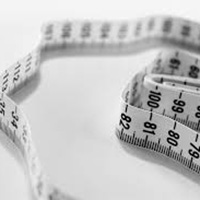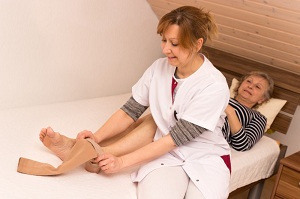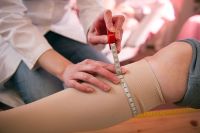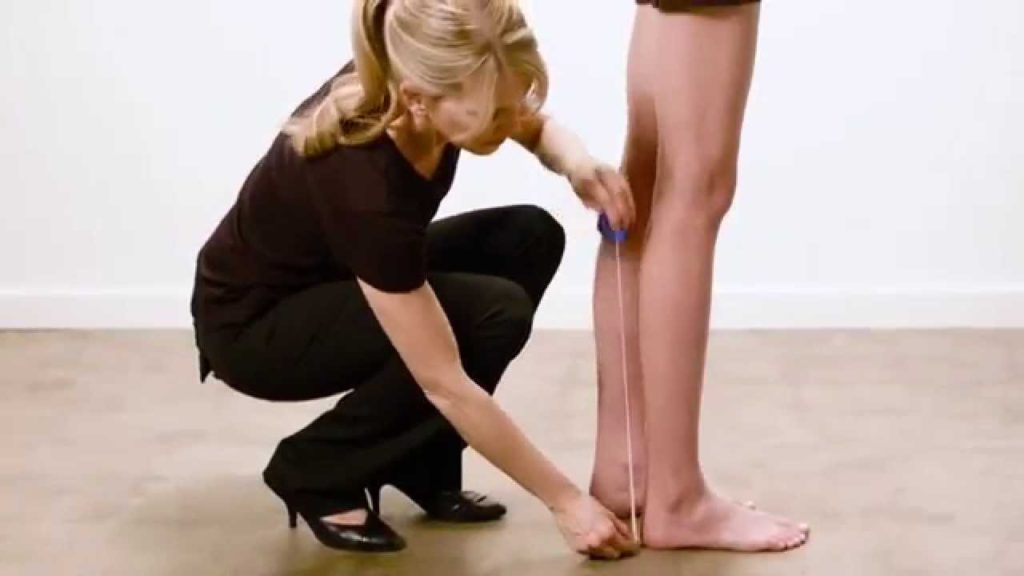Whether you are considering compression socks for work or for medical reasons, there are plenty of benefits to wearing a pair. But they are not like other socks.
“Compression socks – sometimes referred to as pressure socks – gently squeeze your legs in a way that helps promote blood flow from the legs back toward the heart.”
This pressure helps guard against problems like ulcers in the veins, light-headedness when standing (which can lead to fainting and falling), pain from varicose veins and potentially fatal deep vein thrombosis (DVT).
Compression socks also help with the leg pain and swollen ankles that comes along with sitting at a desk or in the driver’s seat all day.
Compression stockings are not just for “old folks” with health struggles like diabetes; they’re for healthy working people in the prime of their life, too. But in order to experience all the benefits of a good pair of these kind of socks, you’ll need accurate measurements.
Getting Ready to Measure
Measuring for pressure socks begins like any other process: you must gather the equipment needed to do the job.
Choose a Measuring Tape

In this case, the leg, calf, and ankle to be sized are needed, as well as a sewing measuring tape. The flexibility of the tape allows for better measurements of the curved, often irregular shapes of people’s legs, as well as easier viewing of the numbers as you measure.
Care must be taken not to stretch the sewing tape. Checking the sewing tape against a ruler, yardstick or a second measuring tape will ensure that what is measured is accurate.
Remove Unnecessary Garments
Measurements for compression socks have to be taken the same way as measurements for other clothes. That is, the way they are measured should reflect the way they are worn. Since socks are generally inner garments, in that they are worn directly on the skin, the person being measured will need to be barefooted.
Keep the pants or skirt clear of the feet and parts of the leg to be measured. This may require removing the pants or skirt entirely. Taking measurements over such clothes will yield inaccurate information, making the socks fit badly and leading to discomfort or possible harm.
How to Take The Measurements for Socks
Collecting measurements are fairly simple. Follow the guidelines below to get the most accurate sizing for yours.
Ask for Help
The best way to get proper measurements for your compression socks is to seek professional assistance. Many durable medical equipment stores will have staff on hand who are trained in how to measure these kinds of stockings. Additionally, for persons whose mobility is limited, the staff are able to help measure difficult to reach places.

Not everybody has easy access to professional fitting, however, and most fitters will not be happy to send their sizing information out of the store. For people who order pressure socks online, knowing how to size them becomes vital. Then you can guide a friend or family member as they help you with measurements.
Which measurements need to be taken depend on what type of sock is to be worn. They come in knee-high and thigh-high varieties, as well as in other garment types. Whatever their length, the general principles will remain consistent.
Measure the Ankle First
Most measurements have to work from the outside in. With socks, this means beginning from the ankle and moving up the leg. This makes sense since the ankle is the focus of compression.
The ankle is the narrowest point of the leg, and it often gets “skipped over” when it comes to fitting regular clothing (that is, regular socks stretch to fit the foot and calf, leaving them loose around the ankle and allowing for swelling and blood to gather in and around the joint).
Ankle size corresponds broadly with shoe size, though there can be exceptions. In general, the part of the sock that covers the foot does not need a separate measurement, as having just the ankle measurement with do.

The measurement is not taken directly on the ankle bone, however. The narrowest point of the leg is usually just above the ankle bone, perhaps half an inch, measure this part of the leg.
Place the sewing tape where it can be held easily by one hand and bring the tape around the leg with the other hand. The sewing tape should be made to completely encircle the ankle. Keep the tape perpendicular to the leg (not slanting up or down, which will give a skewed and inaccurate measurement).
The tape should be snug to the skin but do not pull it so tightly that it presses into the skin or becomes stretched. If the tape is pressing into the skin, your measurement will result in socks with too much pressure. Stretching the tape will result in socks that provide too little compression. Be sure to document down the result.
Measure the Calf
The next measurement will be at the thickest part of the calf. For most people, this will be not far below the knee, perhaps a hand’s width.

Once again, the sewing tape is placed where it can be held easily by one hand while the other brings the tape around the leg, perpendicular to the leg. Keep the tape snug to the skin, but not pressing into it; the tape should not be stretched. The sewing tape should be made to completely encircle the calf. Write down the result right away, just in case.
Your pressure sock will exert less compression at this point of the leg than at the ankle. The reasoning behind this varied compression along the length of the socks is that it helps to push blood back towards the heart. Better circulation is the key to reducing pain and swelling of the feet and legs.
Measure the Thigh
For thigh-high pressure level socks, the next measurement will be at the overall thickest part of the leg. This is usually at the top of the thigh, just beneath the buttocks.
While ankle measurements are easier to take while seated, the measurement at the top of the thigh has to be taken while standing. As noted above, professional fitters can help when mobility is a concern. Here, the sewing tape is placed where it can be held easily by one hand while the other brings the tape around the leg, perpendicular to the leg.
Keep the tape snug to the skin, but not pressing into it, nor stretching the tape. The sewing tape should be made to completely encircle the thigh; the resulting measure should, yet again, be written down promptly. Fit is especially important here, as ill-fitting socks so high on the leg can result in chafing sensitive areas.
Take the length of the Leg

After the measurements around the leg are taken, the length of the leg must be measured.
- You’ll need to sit with your bare foot flat on the ground and the knee bent at a right angle.
- Hold the sewing tape to the floor on the outside of the foot, in line with the ankle, and measure directly up to a finger’s breadth below the knee.
- As before, the tape should not be stretched, and the resulting measure should be recorded promptly.
Thigh-High Socks
- Stand with your bare foot flat on the ground and your leg as straight as you normally keep it when standing.
- Do not lock your knee, but do not bend it either. You will, instead, bend at the waist to hold the sewing tape to the floor on the back of the heel.
- Straighten to hold the sewing tape flush against the skin and measure up to the bottom of the buttocks.
- Once again, the tape should not be stretched, and the resulting measure should be recorded promptly.
Admittedly, the motion for self-assessing the length of a thigh-high sock is awkward, involving twisting and bending. It may not be feasible for you to do it all in one shot. If assistance is not readily on hand, you can measure from heel to knee:
- Hold the sewing tape flush to the back of the knee and, using the hand that had held the sewing tape to the ground, slide up from the knee to the bottom of the buttock.
- The tape should not move in such a case but be “pinned” in advance of the second measurement.
- The tape should not be stretched, and the resulting measure should be recorded promptly. There are a lot of numbers to track, and it is easy to lose or confuse them if records are not kept.
Popular Articles on ComproGear
How Long to Wear Compression Socks for Edema Compression Socks for Edema
Rose Toy What is Rose Toy?
Sock Size and Compression Levels
Note that physicians will sometimes prescribe socks for their patients. In such cases, the physician knows how much compression is needed, usually expressed in terms of mmHg – mmHg stands for millimeters of mercury, per Merriam-Webster; it’s the same way blood pressure is measured.
For those seeking compression without a physician’s recommendation, not that these socks usually come in various ranges. Most commonly you will see ranges of 5 or 10 mmHg, such as 10-15 mmHg, 20-30 mmHg, etc.
Because these socks do alter the way blood flows through the feet and lower legs, using the least compression possible to do what needs to be done is recommended. Some trial and error might be needed to find the level of compression that’s right for you.
Conclusion
The figures you have collected from these measurements will allow for reasonably accurate sizing of a set of pressure socks. The pressure socks are mass-produced, so there will more likely be ranges of sizes than specifically tailored fits. Possibly, there may be variations in the production run.
Even rough numbers, though, will provide a better fit than no numbers, and good numbers will help you find a set of socks to meet your needs.
This page last updated December 15, 2022
